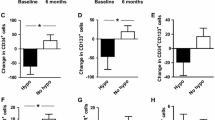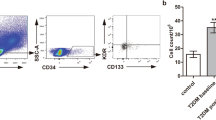Abstract
Circulating endothelial progenitor cells (EPCs) are involved in the repairing mechanisms of vascular damage. Glucose variability may contribute to the development of chronic vascular complications of diabetes. We evaluated whether reducing glucose variability with continuous subcutaneous insulin infusion (CSII) would increase circulating levels of EPCs in type 1 diabetes. The study population consisted of 106 type 1 diabetic patients: 41 subjects considered eligible for CSII completed a 6-month follow-up. Sixty-five patients on intensified insulin therapy with multiple daily injections served as control group. Seven EPCs phenotypes were assessed by flow cytometry, and glucose variability by mean amplitude of glycemic excursions (MAGE). Both CD34+KDR+ [difference between groups 32.0, 95 % CI (19.6–44.4) number/106 cells, P < 0.001] and CD34+KDR+CD133+ [12.5 (5.5–19.5), P < 0.001)] cell count increased at endpoint in the CSII group, associated with a reduction of MAGE [−1.1 (−2.1 to −0.1), P = 0.026]. No changes occurred in the control group. In multivariate analyses, changes in MAGE were independently associated with changes in both CD34+KDR+ (P = 0.019) and CD34+KDR+CD133+ (P = 0.022) cell count. Reducing glucose variability with CSII in type 1 diabetes increases circulating EPCs levels, suggesting a novel mechanism of vascular damage by oscillating glucose.



Similar content being viewed by others
References
A. Avogaro, M. Albiero, L. Menegazzo, S. de Kreutzenberg, G.P. Fadini, Endothelial dysfunction in diabetes: the role of reparatory mechanisms. Diabetes Care 34(Suppl 2), S285–290 (2011)
K.Y. Howangyin, J.S. Silvestre, Diabetes mellitus and ischemic diseases: molecular mechanisms of vascular repair dysfunction. Arterioscler. Thromb. Vasc. Biol. 34, 1126–1135 (2014)
S.A. Sorrentino, F.H. Bahlmann, C. Besler, M. Müller, S. Schulz, N. Kirchhoff, C. Doerries, T. Horváth, A. Limbourg, F. Limbourg, D. Fliser, H. Haller, H. Drexler, U. Landmesser, Oxidant stress impairs in vivo reendothelialization capacity of endothelial progenitor cells from patients with type 2 diabetes mellitus: restoration by the peroxisome proliferator-activated receptor gamma agonist rosiglitazone. Circulation 116, 163–173 (2007)
S.L. Hernandez, J.H. Gong, L. Chen, I.H. Wu, J.K. Sun, H.A. Keenan, G.L. King, Characterization of circulating and endothelial progenitor cells in patients with extreme-duration type 1 diabetes. Diabetes Care 37, 2193–2201 (2014)
T. Hörtenhuber, B. Rami-Mehar, M. Satler, K. Nagl, C. Höbaus, F. Höllerl, R. Koppensteiner, G. Schernthaner, E. Schober, G.H. Schernthaner, Endothelial progenitor cells are related to glycemic control in children with type 1 diabetes over time. Diabetes Care 36, 1647–1653 (2013)
M. Gili, A. Orsello, S. Gallo, M.F. Brizzi, Diabetes-associated macrovascular complications: cell-based therapy a new tool? Endocrine 44, 557–575 (2013)
S. Frontoni, P. Di Bartolo, A. Avogaro, E. Bosi, G. Paolisso, A. Ceriello, Glucose variability: an emerging target for the treatment of diabetes mellitus. Diabetes Res. Clin. Pract. 102, 86–95 (2013)
F. Cavalot, Do data in the literature indicate that glycaemic variability is a clinical problem? Glycaemic variability and vascular complications of diabetes. Diabetes Obes. Metab. 15(Suppl 2), 3–8 (2013)
American Diabetes Association, Standards of medical care in diabetes—2015. Diabetes Care 38(Supp l1), S41–S48 (2015)
M.I. Maiorino, G. Bellastella, M. Petrizzo, M.R. Improta, C. Brancario, F. Castaldo, L. Olita, D. Giugliano, K. Esposito, Treatment satisfaction and glycemic control in young Type 1 diabetic patients in transition from pediatric health care: CSII versus MDI. Endocrine 46, 256–262 (2014)
D. Bruttomesso, D. Crazzolara, A. Maran, S. Costa, M. Dal Pos, A. Girelli, G. Lepore, M. Aragona, E. Iori, U. Valentini, S. Del Prato, A. Tiengo, A. Buhr, R. Trevisan, A. Baritussio, In Type 1 diabetic patients with good glycaemic control, blood glucose variability is lower during continuous subcutaneous insulin infusion than during multiple daily injections with insulin glargine. Diabet. Med. 25, 326–332 (2008)
M.I. Maiorino, E. Della Volpe, L. Olita, G. Bellastella, D. Giugliano, K. Esposito, Glucose variability inversely associates with endothelial progenitor cells in type 1 diabetes. Endocrine 48, 342–345 (2015)
J.C. Pickup, P. Hammond, NICE guidance on continuous subcutaneous insulin infusion 2008: review of the technology appraisal guidance. Diabet. Med. 26, 1–4 (2009)
M.I. Maiorino, G. Bellastella, M. Petrizzo, E. Della Volpe, R. Orlando, D. Giugliano, K. Esposito, Circulating endothelial progenitor cells in type 1 diabetic patients with erectile dysfunction. Endocrine 49, 415–421 (2015)
N. Mauras, L. Fox, K. Englert, R.W. Beck, Continuous glucose monitoring in type 1 diabetes. Endocrine 43, 41–50 (2013)
G.P. Fadini, A reappraisal of the role of circulating (progenitor) cells in the pathobiology of diabetic complications. Diabetologia 57, 4–15 (2014)
N. Werner, S. Kosiol, T. Schiegl, P. Ahlers, K. Walenta, A. Link, M. Böhm, G. Nickenig, Circulating endothelial progenitor cells and cardiovascular outcomes. N. Engl. J. Med. 353, 999–1007 (2005)
S. Sen, S.P. McDonald, P.T. Coates, C.S. Bonder, Endothelial progenitor cells: novel biomarker and promising cell therapy for cardiovascular disease. Clin. Sci. (Lond.) 120, 263–283 (2011)
C. Dessapt, J. Karalliedde, M. Hernandez-Fuentes, P. Prieto Martin, G. Maltese, N. Dattani, R. Atkar, G. Viberti, L. Gnudi, Circulating vascular progenitor cells in patients with type 1 diabetes and microalbuminuria. Diabetes Care. 33, 875–877 (2010)
L. Sibal, A. Aldibbiat, S.C. Agarwal, G. Mitchell, C. Oates, S. Razvi, J.U. Weaver, J.A. Shaw, P.D. Home, Circulating endothelial progenitor cells, endothelial function, carotid intima–media thickness and circulating markers of endothelial dysfunction in people with type 1 diabetes without macrovascular disease or microalbuminuria. Diabetologia 52, 1464–1473 (2009)
L. Monnier, E. Mas, C. Ginet, F. Michel, L. Villon, J.P. Cristol, C. Colette, Activation of oxidative stress by acute glucose fluctuations compared with sustained chronic hyperglycemia in patients with type 2 diabetes. JAMA 295, 1681–1687 (2006)
I.M. Wentholt, W. Kulik, R.P. Michels, J.B. Hoekstra, J.H. DeVries, Glucose fluctuations and activation of oxidative stress in patients with type 1 diabetes. Diabetologia 51, 183–190 (2008)
E.S. Kilpatrick, A.S. Rigby, S.L. Atkin, The effect of glucose variability on the risk of microvascular complications in type 1 diabetes. Diabetes Care 29, 1486–1490 (2006)
E.S. Kilpatrick, A.S. Rigby, S.L. Atkin, Effect of glucose variability on the long-term risk of microvascular complications in type 1 diabetes. Diabetes Care 32, 1901–1903 (2009)
G. Derosa, I. Franzetti, F. Querci, D. Romano, A. D’Angelo, P. Maffioli, Glucose-lowering effect and glycaemic variability of insulin glargine, insulin detemir and insulin lispro protamine in people with type 1 diabetes. Diabetes Obes. Metab. 17, 554–559 (2015)
T. Nakamura, K. Sakaguchi, A. So, S. Nakajima, M. Takabe, H. Komada, Y. Okuno, Y. Hirota, T. Nakamura, K. Iida, M. Kajikawa, M. Nagata, W. Ogawa, S. Seino, Effects of insulin degludec and insulin glargine on day-to-day fasting plasma glucose variability in individuals with type 1 diabetes: a multicentre, randomised, crossover study. Diabetologia (2015). doi:10.1007/s00125-015-3648-y
M.I. Maiorino, M. Petrizzo, A. Capuano, D. Giugliano, K. Esposito, The development of new basal insulins: is there any clinical advantage with their use in type 2 diabetes? Expert Opin. Biol. Ther. 14, 799–808 (2014)
T. Battelino, J.Š. Omladič, M. Phillip, Closed loop insulin delivery in diabetes. Best Pract. Res. Clin. Endocrinol. Metab. 29, 315–325 (2015)
E. Standl, O. Schnell, A. Ceriello, Postprandial hyperglycemia and glycemic variability: should we care? Diabetes Care 34(Suppl 2), S120–127 (2011)
L. Heinemann, G.A. Fleming, J.R. Petrie, R.W. Holl, R.M. Bergenstal, A.L. Peters, Insulin pump risks and benefits: a clinical appraisal of pump safety standards, adverse event reporting, and research needs. A joint statement of the European Association for the Study of Diabetes and the American Diabetes Association Diabetes Technology Working Group. Diabetes Care 38, 716–772 (2015)
Author information
Authors and Affiliations
Corresponding author
Ethics declarations
Conflict of interest
The authors have nothing to declare.
Additional information
The METRO Study Group members are listed in Appendix.
Appendix
Appendix
The Management and Technology for Transition (METRO) Study Group
Medical expertise
Filomena Castaldo, MD, Diabetes Center at Second University of Naples, Naples, Italy.
Maria Rosaria Improta, MD, PhD, Diabetes Center at Second University of Naples, Naples, Italy.
Michela Petrizzo, MD; IOS and Coleman – Medicina Futura Medical Center, Centro Direzionale, Naples, Italy.
Nursing assistance
Concetta Verazzo, Diabetes Center at Second University of Naples, Naples, Italy.
Rights and permissions
About this article
Cite this article
Maiorino, M.I., Casciano, O., Volpe, E.D. et al. Reducing glucose variability with continuous subcutaneous insulin infusion increases endothelial progenitor cells in type 1 diabetes: an observational study. Endocrine 52, 244–252 (2016). https://doi.org/10.1007/s12020-015-0686-7
Received:
Accepted:
Published:
Issue Date:
DOI: https://doi.org/10.1007/s12020-015-0686-7




